
Roots
The journey into understanding textured hair begins not with products, but with the very structure that makes each coil and curl so distinct. To truly care for these unique strands, one must first listen to the whispers of the hair itself, recognizing its fundamental nature. Porosity, often spoken of in hushed tones or as a complex scientific term, is at its core a simple conversation about how well hair accepts and holds onto life-giving moisture.
It is a dialogue between the hair’s outer layer, the cuticle, and the water it encounters, a conversation that varies dramatically across the rich spectrum of textured hair. This understanding is a gentle beckoning into the elemental, a foundation for nurturing these magnificent strands.
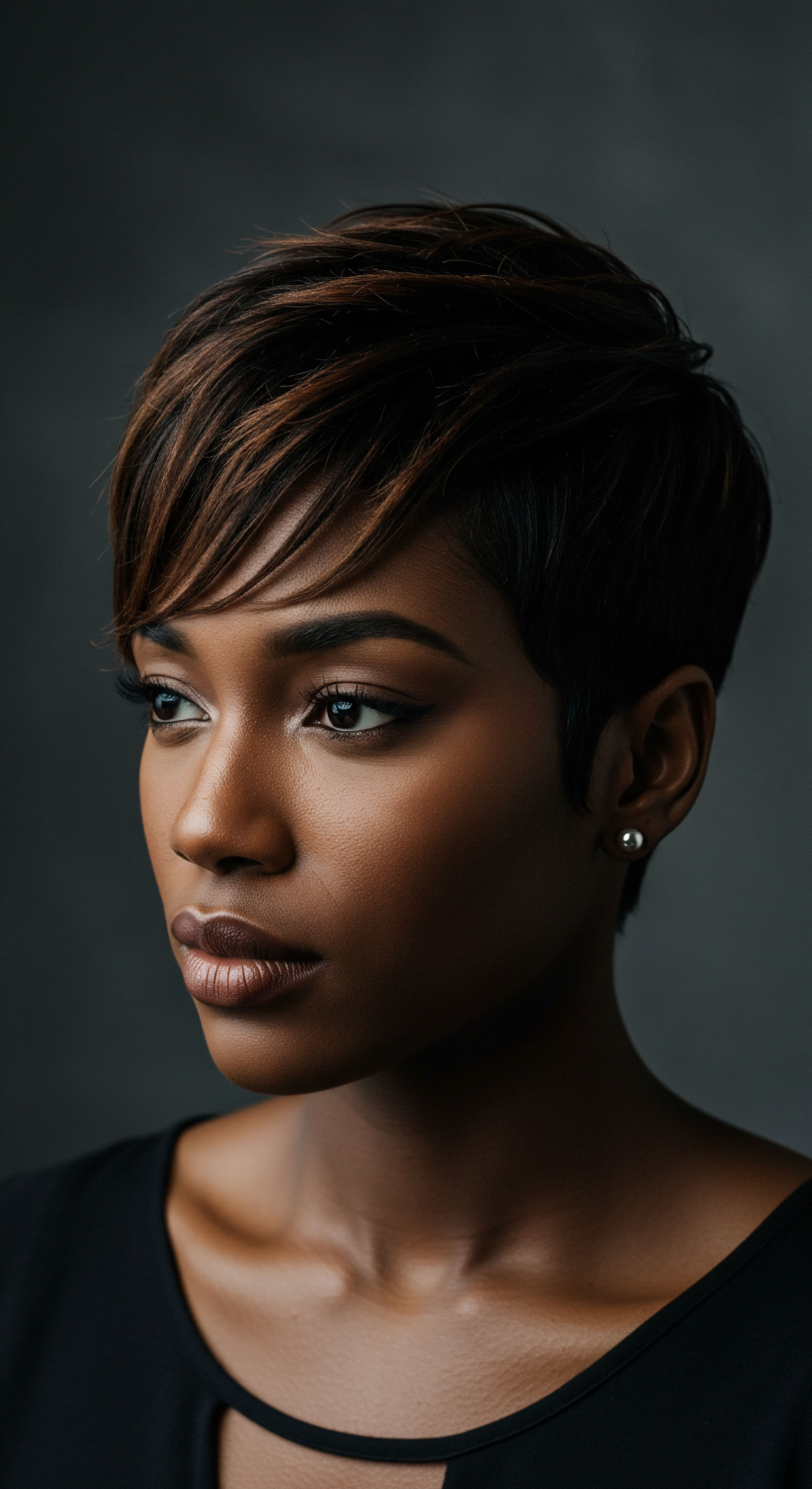
Hair’s Outer Veil ❉ The Cuticle
Every strand of hair, whether a gentle wave or a tight coil, is protected by an outer layer known as the cuticle. Picture it as a series of overlapping scales, much like the shingles on a roof, or perhaps the delicate petals of a closed flower. These scales are the guardians of the hair’s inner life, controlling the passage of moisture and other substances. In hair with low porosity, these cuticles lie closely packed and flat, creating a formidable barrier.
This natural seal makes it difficult for water and products to penetrate, yet once moisture does find its way in, it is held with steadfast resolve. Conversely, hair exhibiting high porosity often possesses cuticles that are more open, or even lifted, resembling a flower in full bloom. This structure readily invites moisture in, but, with equal swiftness, allows it to escape, leading to persistent dryness.

Porosity’s Whisper ❉ A Spectrum of Absorption
Porosity is not a fixed, singular state; it exists along a continuous spectrum, from the tightly sealed nature of low porosity to the widely open embrace of high porosity. Each point on this spectrum presents its own unique challenges and rewards. Textured hair, by its very helical shape and often flattened elliptical cross-section, is inherently predisposed to certain porosity characteristics.
The natural bends and twists can cause the cuticle layers to lift slightly, contributing to what is often perceived as higher porosity. This structural reality means that the natural oils, or sebum, produced by the scalp face a more arduous journey traveling down the length of the hair shaft, leaving the mid-lengths and ends particularly vulnerable to dryness.
Porosity describes hair’s capacity to absorb and retain moisture, a characteristic influenced by the cuticle’s structure and its unique behavior in textured strands.
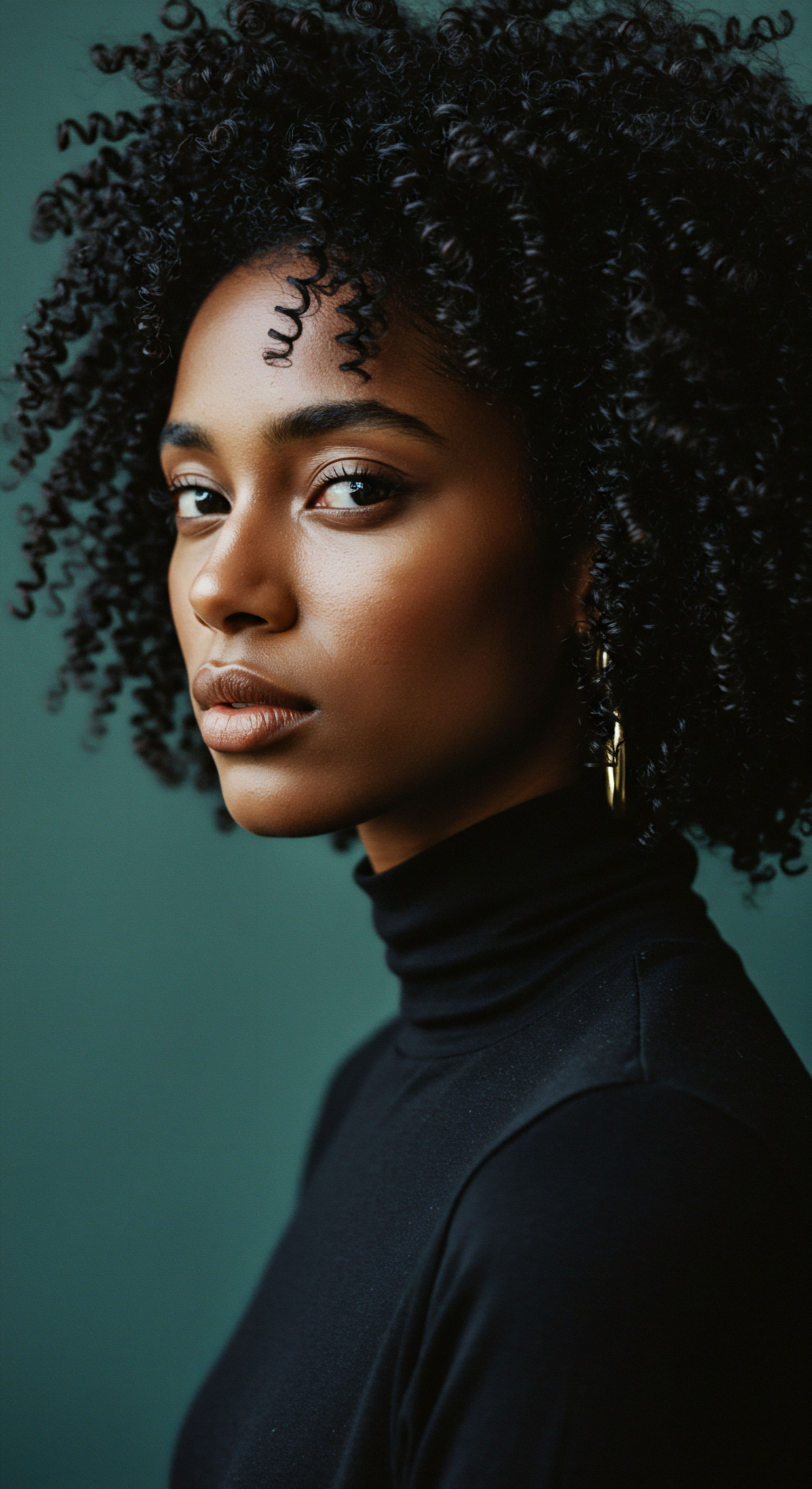
The Curl’s Intricacy and Porosity
The very architecture of textured hair plays a significant role in its porosity. Unlike straight strands where the cuticle layers can lie uniformly flat, the coiling and kinking patterns of textured hair introduce points where the cuticle naturally lifts. This inherent characteristic means that while some textured hair can exhibit low porosity, a greater tendency leans towards higher porosity, especially as hair extends from the scalp. The greater the curl, the more turns and bends exist, potentially creating more opportunities for the cuticle to be less uniformly sealed.
Consider the delicate balance required for hair to thrive. For textured hair, this balance is often a more complex equation. The challenges associated with porosity are not merely superficial; they delve into the very essence of hair health, impacting everything from hydration levels to elasticity.
A study published in the Journal of Investigative Dermatology Symposium Proceedings highlighted that increased porosity, particularly in long hair, can be a result of “weathering,” a gradual breakdown of the hair cuticle and cortex from root to tip due to everyday wear and tear. This breakdown can lead to split ends, damaged cuticles, and eventually, breakage.
Weathering ❉ The slow breakdown of the hair cuticle and cortex from root to tip, especially in longer strands, leading to increased porosity and vulnerability.
| Porosity Type Low Porosity |
| Cuticle State Tightly packed, flat |
| Moisture Absorption Resists absorption |
| Moisture Retention Retains well once absorbed |
| Common Challenges Product buildup, slow drying, difficulty wetting hair |
| Porosity Type Medium Porosity |
| Cuticle State Slightly raised, flexible |
| Moisture Absorption Absorbs well |
| Moisture Retention Retains reasonably well |
| Common Challenges Requires balanced care |
| Porosity Type High Porosity |
| Cuticle State Open, lifted, or damaged |
| Moisture Absorption Absorbs quickly |
| Moisture Retention Loses quickly |
| Common Challenges Dryness, frizz, breakage, quick fading of color |
| Porosity Type Understanding these differences is foundational for personalized textured hair care. |

Ritual
Moving from the foundational understanding of porosity, our thoughts turn to the daily and periodic practices that shape our hair’s existence. The selection of products, the cadence of cleansing, and the very gestures of styling become a kind of ritual, deeply personal and profoundly impactful. For textured hair, where the interplay of structural design and environmental factors is so pronounced, these rituals take on an added layer of significance.
They are not merely steps in a routine; they are acts of care, of listening, of responding to the hair’s inherent needs. This section seeks to offer guidance in navigating these practical aspects, acknowledging the desire for actionable wisdom that honors the unique qualities of each strand.
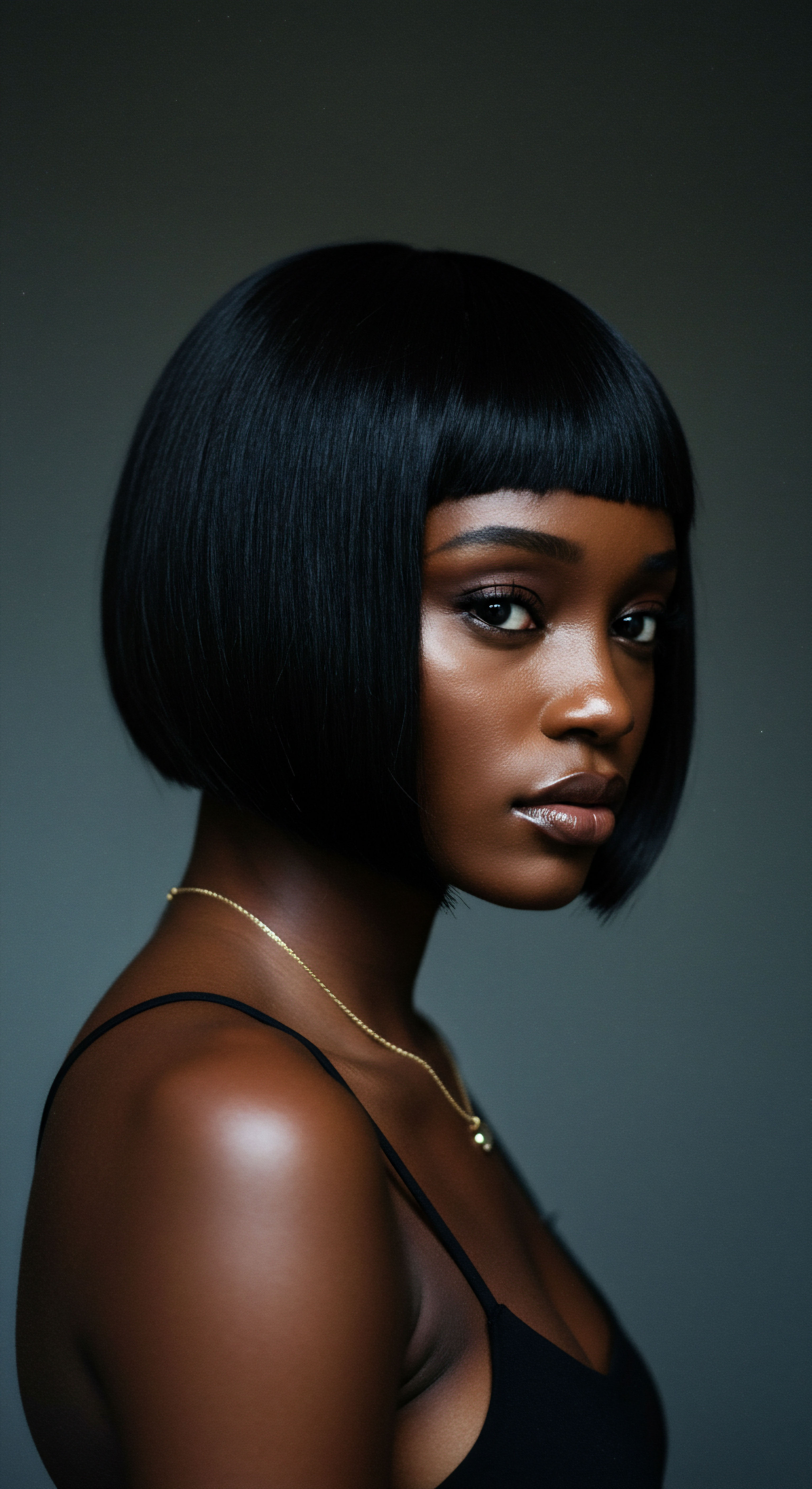
Hydration’s Dance ❉ The Product Absorption Riddle
One of the most immediate challenges presented by varying porosity levels in textured hair lies in the realm of hydration. For those with low porosity, the tightly bound cuticles act as a formidable shield, making it a true test of patience to get water and conditioning agents to penetrate the hair shaft. Products can seem to sit on the surface, creating a heavy, coated sensation rather than offering deep moisture. This resistance can lead to persistent dryness beneath a deceptively shiny exterior.
Conversely, high porosity hair, with its eager, open cuticles, drinks in moisture with astonishing speed. Yet, this quick absorption is often matched by an equally rapid loss, leaving strands feeling parched and brittle soon after moisturizing.
This dynamic creates a complex dance of product application. For low porosity hair, the ritual often involves gentle heat to encourage the cuticle to lift, allowing conditioners to truly seep in. This could be as simple as using a warm towel wrapped around the head after applying a deep conditioner, or sitting under a hooded dryer. For high porosity strands, the challenge is not absorption, but retention.
Here, the focus shifts to layering lighter, water-based hydrators with heavier emollients and sealing oils to lock in the moisture that has been absorbed. The LOC (Liquid, Oil, Cream) or LCO (Liquid, Cream, Oil) methods become valuable tools in this moisture-sealing endeavor.

Styling’s Demand ❉ Frizz and Breakage
The inherent structural characteristics of textured hair, compounded by porosity variations, contribute significantly to common styling challenges like frizz and breakage. High porosity hair, with its raised cuticles, is particularly susceptible to frizz, as moisture from the surrounding environment can easily enter the hair shaft, causing it to swell and disrupt the curl pattern. This constant swelling and deswelling, known as hygral fatigue, weakens the hair over time. For low porosity hair, the challenge manifests differently; products that fail to penetrate can lead to dullness and a lack of definition, as the hair’s true curl pattern remains obscured beneath a surface layer of unabsorbed product.
The careful selection of products and the mindful application of heat can transform how textured hair responds to its care regimen, directly addressing porosity’s varied demands.
Breakage, a persistent concern for many with textured hair, is often linked to porosity. High porosity hair, being more fragile due to its compromised cuticle, is more prone to mechanical damage from daily grooming. Even seemingly gentle acts like combing or brushing can lead to significant breakage if the hair is not adequately lubricated and detangled. Textured hair, by its very nature, is more prone to tangling, further increasing the risk of mechanical stress.
Low porosity hair, while less prone to external damage, can become brittle from internal dryness if moisture cannot reach the cortex. This means that both ends of the porosity spectrum face distinct, yet equally impactful, risks related to hair integrity.
Hygral Fatigue ❉ The weakening of hair fibers caused by repeated swelling from water absorption and subsequent deswelling upon drying, particularly problematic for high porosity hair.
- Detangling ❉ Always perform on damp or wet hair, saturated with a conditioner offering ample slip, to minimize friction and prevent breakage.
- Cleansing ❉ Low porosity hair often benefits from clarifying shampoos to prevent product buildup, which can impede moisture absorption.
- Sealing ❉ High porosity hair requires effective sealing with oils or creams to lock in moisture after hydration, counteracting rapid water loss.
| Porosity Type Low Porosity |
| Product Characteristics Lightweight, water-based, humectant-rich, less protein |
| Application Technique Apply to wet hair, use gentle heat (steamer, warm towel) for penetration |
| Porosity Type High Porosity |
| Product Characteristics Heavier creams, butters, sealing oils, protein treatments |
| Application Technique Layer products (LOC/LCO method), focus on sealing in moisture |
| Porosity Type Tailoring product choices and application methods to porosity can greatly enhance hair health. |

Relay
As we deepen our conversation, we move beyond the immediate and the practical, venturing into the interconnected web of factors that shape the textured hair experience. This exploration is not merely about understanding; it is about acknowledging the intricate dance between science, cultural heritage, and the broader world around us. What deeper complexities does the porosity of textured hair unveil when viewed through a wider lens, considering not just its biological makeup, but also the historical echoes and environmental dialogues that influence its very being? This section invites a profound inquiry, drawing upon research and observation to paint a more complete picture.
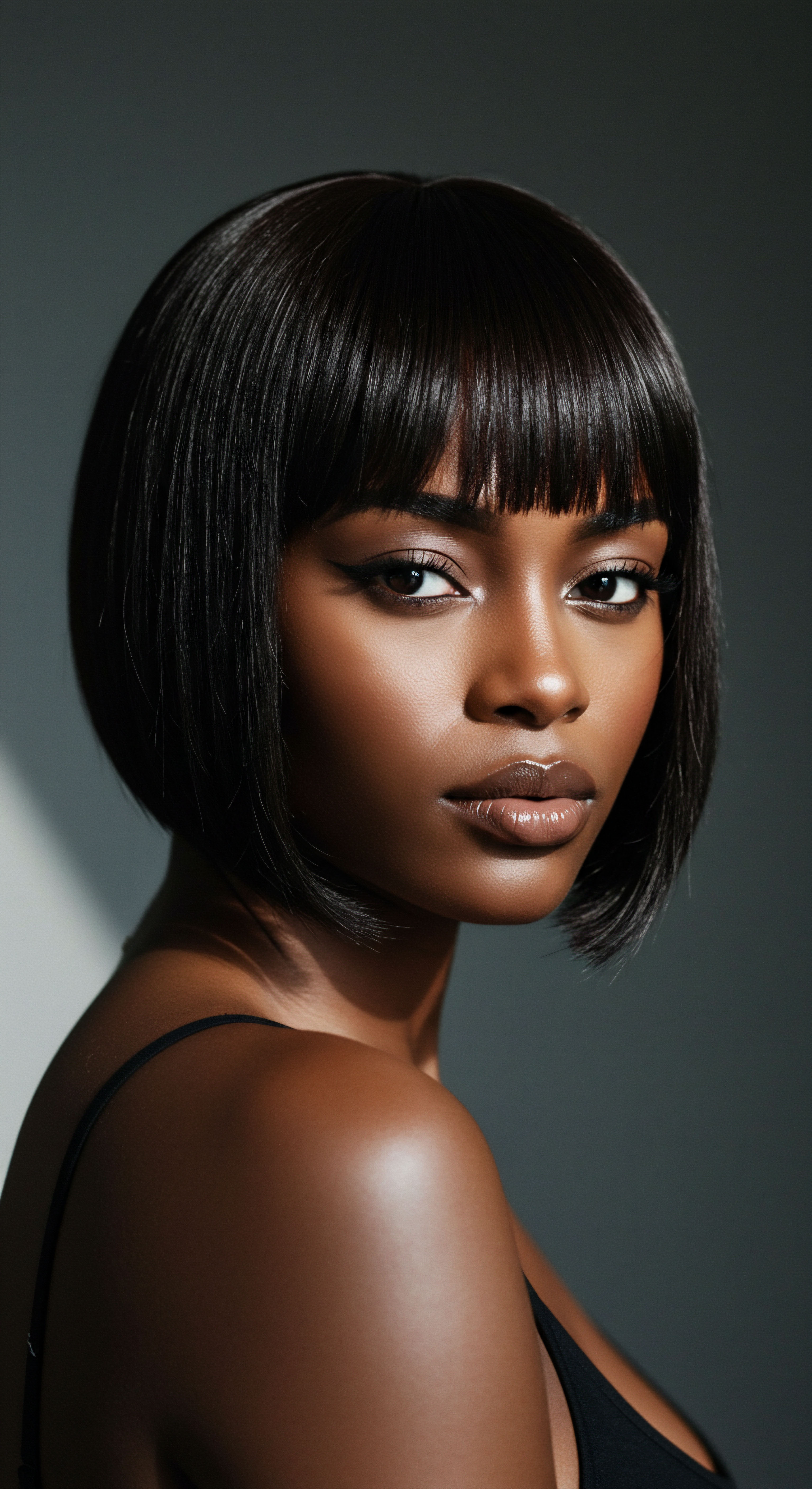
Environmental Dialogue ❉ External Stressors and Hair’s Integrity
Hair porosity, while influenced by genetics, is profoundly affected by external environmental factors and daily practices. The delicate cuticle, the hair’s primary defense, is constantly interacting with its surroundings. Exposure to ultraviolet (UV) radiation from the sun, for example, can degrade this protective layer, causing microscopic voids within the hair shaft.
UV-B rays, in particular, are known to break down essential proteins, accelerating porosity and weakening the hair’s structural integrity. Similarly, mechanical stresses from routine grooming, such as aggressive combing or brushing, and the repeated cycles of wetting and drying (hygral fatigue), can cause the cuticle to lift and chip away, increasing porosity over time.
Consider the cumulative impact of these daily encounters. A study investigating the effects of common hair care protocols on textured hair revealed significant changes in water permeability, surface topography, and appearance after multiple cycles of washing, blow-drying with combing, and hot flat iron styling, simulating routines spanning one to six months. This research underscored the damaging potential of routine practices for textured hair, emphasizing the need for targeted cosmetic solutions to protect and repair these fibers. Even seemingly innocuous actions, when repeated, can contribute to the hair’s gradual alteration, making it more susceptible to damage and moisture loss.

Chemical Alterations ❉ A Change in Hair’s Fabric
Chemical treatments, such as coloring, bleaching, and chemical straightening, dramatically alter the hair’s porosity. These processes are designed to penetrate the cuticle to effect changes within the cortex, but in doing so, they inevitably lift and can damage the cuticle layers. Hair dyes and bleaching agents strip melanin and proteins, creating microscopic voids and increasing the hair’s ability to absorb, but also to lose, moisture. This increased porosity means that chemically treated hair can quickly absorb water, but it also dries rapidly and is more prone to frizz and breakage.
The very nature of textured hair, with its inherent structural predispositions, means it often requires specialized attention to maintain its optimal moisture balance.
For textured hair, which may already possess a more open cuticle structure or fewer cuticle layers than straight hair, the impact of chemical processing can be particularly pronounced. Some research suggests that Afro-textured hair has fewer cuticle layers (8-12) compared to Asian hair (more than 12), though more than Caucasian hair (4-7), potentially offering less inherent protection against external stressors. This makes careful consideration of chemical treatments paramount, as over-processing can lead to further damage, increased porosity, and diminished hair health.

Self-Perception and Care ❉ The Cultural Resonance of Hair
Beyond the scientific and practical, the challenges related to textured hair porosity resonate deeply within cultural and personal spheres. For generations, Black and mixed-race individuals have navigated a complex relationship with their hair, often influenced by societal beauty standards that historically privileged straighter textures. The pursuit of manageability and conformity sometimes led to practices that, while achieving desired aesthetic outcomes, inadvertently compromised hair health and porosity.
Hair Mapping ❉ Traditional practices in communities with long histories of textured hair care that involved understanding not just curl pattern, but also porosity, density, elasticity, and environmental responses.
However, a powerful resurgence of the natural hair movement has shifted this conversation, placing emphasis on understanding and celebrating textured hair in its unaltered state. This movement has brought a renewed focus on scientific concepts like porosity, transforming them from obscure terms into widely discussed elements of personalized hair care. Traditional hair care systems, particularly those from regions like Chad and Somalia, recognized the complexities of textured hair centuries before modern science. These communities developed sophisticated “hair mapping” practices, which involved a holistic understanding of hair beyond mere curl pattern, encompassing porosity, density, elasticity, and environmental responses.
This historical wisdom, combined with contemporary scientific understanding, empowers individuals to make informed choices that prioritize hair health. The challenge, then, becomes one of balancing aesthetic desires with the hair’s inherent needs, understanding that a deeper acquaintance with one’s hair—its porosity, its response to the environment, its cultural significance—is the true path to serene strands. This journey of understanding allows for a more compassionate and effective approach to care, one that acknowledges both the scientific realities and the lived experiences of textured hair.
- Genetics ❉ Hair porosity can be influenced by inherited traits, determining the natural state of the cuticle layers.
- Aging ❉ As hair ages, it naturally loses essential proteins and lipids, which can increase porosity over time.
- Climate ❉ Humidity can exacerbate frizz in high porosity hair, as open cuticles readily absorb moisture from the air.
| Factor Category Genetic / Inherent |
| Specific Influences Natural curl pattern, cuticle layering, sebum distribution |
| Impact on Porosity Can predispose hair to higher or lower porosity; natural oil distribution challenges |
| Factor Category Chemical Damage |
| Specific Influences Bleaching, coloring, relaxers, perms |
| Impact on Porosity Increases porosity by lifting/damaging cuticles, creating voids |
| Factor Category Physical Damage |
| Specific Influences Heat styling, aggressive combing, towel drying, tight styles |
| Impact on Porosity Increases porosity through mechanical stress and cuticle erosion |
| Factor Category Environmental Exposure |
| Specific Influences UV rays, pollution, harsh water, humidity |
| Impact on Porosity Degrades cuticle, alters surface lipids, affects moisture balance |
| Factor Category Porosity is a dynamic characteristic, shaped by both intrinsic and extrinsic elements. |
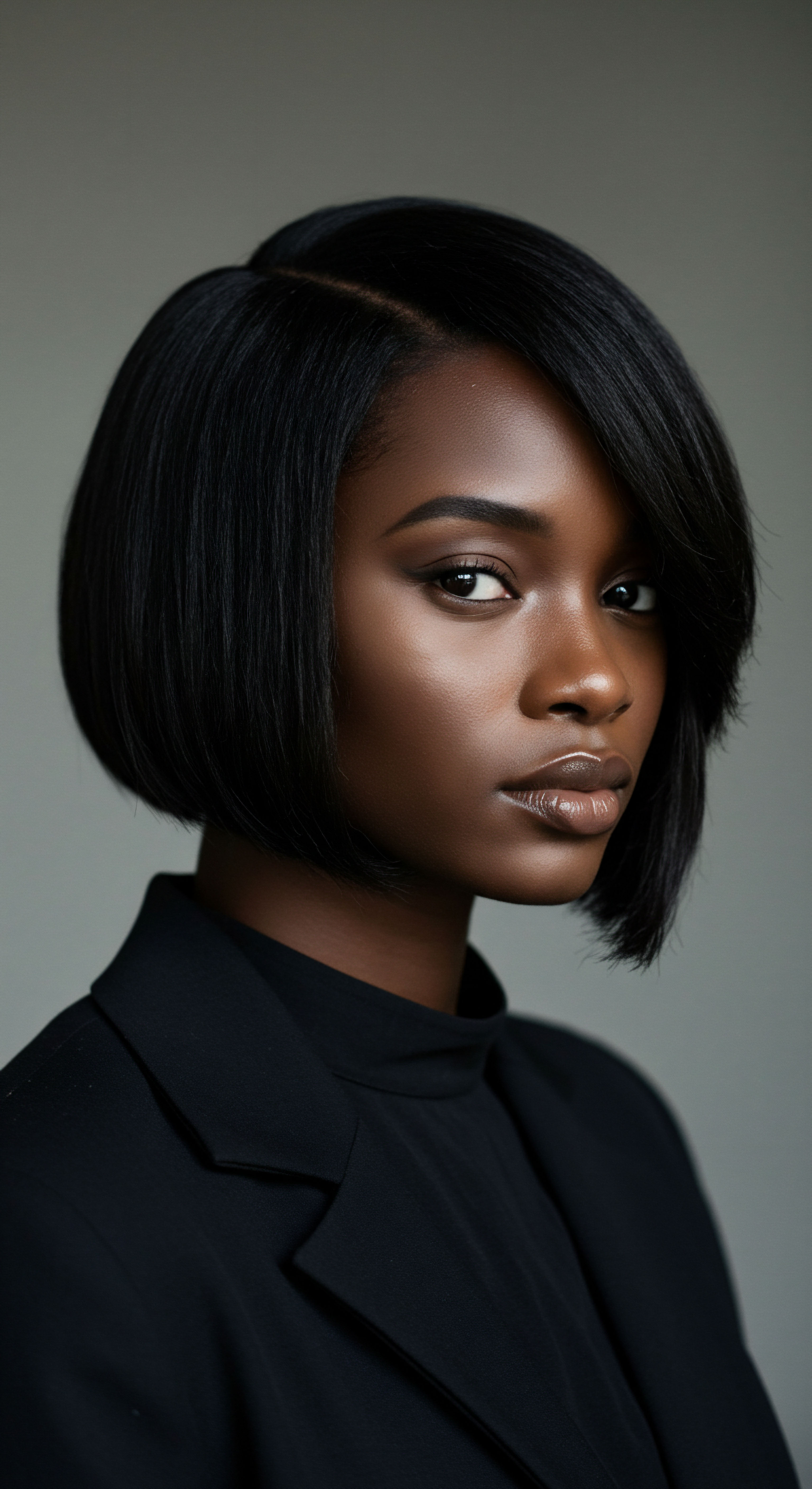
Reflection
The journey through the intricate world of textured hair porosity reveals a landscape rich with scientific wonder, historical wisdom, and deeply personal experiences. It reminds us that hair is never merely an inert collection of strands; it is a living canvas, responding to every touch, every product, every environmental shift. The challenges posed by porosity are not roadblocks, but rather invitations to listen more closely, to learn more deeply, and to approach care with a heightened sense of reverence.
Each coil, each curl, each wave holds its own story of absorption and retention, a unique rhythm in the grand symphony of self-care. Understanding these rhythms allows us to move beyond superficial solutions, fostering a connection that celebrates the inherent beauty and resilience of textured hair in all its glorious forms.

References
- Chow, P. K. (2020). An Overview on Hair Porosity. NYSCC.
- de Almeida, A. G. & Pinto, M. S. (2022). Porosity and Resistance of Textured Hair ❉ Assessing Chemical and Physical Damage Under Consumer-Relevant Conditions. Cosmetics, 9(4), 79.
- Robins, J. (2020). The Science Behind Porosity & Naturally Textured Hair. Red Carpet Curls.
- KeraVada. (2024). Unraveling the Mystery of Hair Porosity (Low and High) ❉ A Deep Dive.
- Medical News Today. (2022). Low porosity hair ❉ What it is, characteristics, and care.
- Halo Haircare Society. (2025). The Truth about Hair Porosity.
- Florae Beauty. (2022). Understanding Hair Porosity and Density ❉ A Guide to Health Hair.
- ResearchGate. (2025). Porosity and Resistance of Textured Hair ❉ Assessing Chemical and Physical Damage Under Consumer-Relevant Conditions.
- Dr. Serkan Aygin. (2025). The Ultimate Guide to High Porosity Hair ❉ Moisture Solutions.
- estherotomi. (2015). BLACK HAIR SCIENCE ❉ THE STRUCTURE OF AFRO TEXTURED HAIR.
- Croda Beauty. (2025). Advancing the future of textured hair solutions.
- Black Afro Hair. (2013). THE SCIENCE OF HAIR – PART ONE (The Basics).
- NaturallyCurly. (2023). 4 Things You Can’t Do When You Have Low Porosity Hair.
- WholEmollient. (2025). Hair Porosity Test at Home | Textured Hair Mapping Guide.
- Joan Morais Cosmetics School Hair Care. (n.d.). Hair Porosity.
- Mielle Organics. (2025). How to Fix High Porosity Hair ❉ Dos and Don’ts.
- Seppic. (2024). Tips to have the best formulation for textured hair.
- The Solid Bar Company. (n.d.). Complete Guide To Curly & Afro-Textured Hair.
- HairKnowHow.Com. (n.d.). High Porosity Hair Guide.
- nylahs naturals. (n.d.). Your Guide To Hair Science And Hair Texture.
- Beautycon.com. (2018). 6 Things You Can’t Do When You Have High Porosity Hair.
- NeoCurly. (2024). Guide For Caring For Low Porosity Curls.
- Nelsie Cosmetics. (2023). Textured hair routine.
- The Shade. (n.d.). How Hair Porosity Affects Hair Colour.
- Healthline. (2019). Low Porosity Hair ❉ What It Means For Your Hair.
- OrganiGrowHairCo. (2023). Low Porosity Hair ❉ Characteristics, Challenges, and Care Tips.
- MDPI. (n.d.). The Genomic Variation in Textured Hair ❉ Implications in Developing a Holistic Hair Care Routine.
- ResearchGate. (n.d.). True porosity measurement of hair ❉ A new way to study hair damage mechanisms.
- Dwell Studio Salon. (2025). Mastering Curl Hydration ❉ Essential Curly Hair Tips & Insights from Curl Specialists.
- Society of Cosmetic Chemists. (n.d.). Curly Chemistry.